Cyclify India is reader-supported! We may receive an associate commission if you purchase through one of the Amazon Associate links on this page! Continue Reading…
The market which was previously dominated by rim-brake has suddenly been overtaken by disc brakes. Everyone who owns a mountain bike worth their salt knows that disc brakes are the greatest type of bicycle brakes for them, and even the most affordable models include them.
Disc brakes are now standard on nearly all types of bicycles, including road cycles, hybrids, full-suspension mountain bikes, and gravel bikes.
Although disc brakes seem to be a part of every aspect of cycling, from the recreational commuter to the Tour de France, mountain bikes were among the first to accept the new technology and helped to pioneer it.
Nevertheless, disc brakes vary in size, purpose, brand, and other aspects, so not all of them are created equal. In the realm of bicycles, disc brakes come in two primary varieties: hydraulic and mechanical.
Some may find the distinction to be insignificant, yet there are several key characteristics that set one type of disc brake apart from the other.
To assist you in making a decision, we’ll examine the features and benefits of both hydraulic vs mechanical disc brakes in this post.
Table of Contents
Difference Between Hydraulic and Mechanical Disc Brakes?

What sets them apart is the method by which force is transferred from the handlebar-mounted brake levers to the brake calipers located in close proximity to the hubs, which distinguishes hydraulic disc brakes from mechanical disc brakes. The steel cable is used in mechanical disc brakes. The brake line for hydraulic disc brakes is filled with fluid.
Brake fluid is forced into the brake line from the master cylinder, located in the lever body, by a plunger when a hydraulic disc brake lever is squeezed. Fully filled with fluid, the brake line is sealed. There is pressure in the line as a result.
The brake pads are pushed up against the rotors by the braking calipers’ piston, which is pushed by this pressure. The fact that fluids don’t compress makes this conceivable. You’ll find the same technology in the disc brakes of your automobile or motorbike here.
Conversely, mechanical disc brakes operate similarly to rim brakes using a steel wire. A cable that extends all the way to the brake caliper is pulled when the brake lever is pulled. A lever on the caliper is moved by the cable, pushing a piston. In order to stop the bike, friction is created when the piston presses the brake pads up against the rotor.
Mechanical vs Hydraulic Braking System
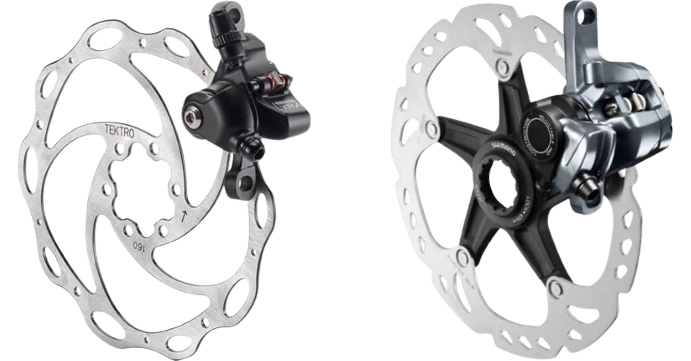
A hydraulic braking system employs fluids to stop or slow down a bicycle, whereas a mechanical braking system mostly uses wires. Compared to hydraulic braking systems, mechanical braking systems are less expensive. In addition, a bicycle’s mechanical disc brakes are simple to service. Brake pads are the only maintenance needed for mechanical brakes. From a performance standpoint, they are solid and efficient.
But if you need even better performance, investing in a hydraulic disc brake is the ideal choice because they outperform mechanical brakes in terms of performance.
With mechanical disc brakes, the brake pads are pulled down onto the rotor by calipers, creating friction that causes the bike to slow down. It is comparable to motorbike disc brakes. Instead, the brake pads are pushed into the rotor by fluid pressure in hydraulic disc brakes.
There’s no law that says hydraulic disc brakes can’t be used on various kinds of bicycles; nonetheless, mountain bikes often use them, and road bicycles utilize disc brakes.
Overview of Disc Brakes
The 1950s saw the introduction of disc brakes. But in the early 1970s, Shimano introduced the first well-recognized hydraulic disc brake.
The disc brake wasn’t truly ready for manufacturing bikes until the late 1990s when the Hayes Mag disc brake was unveiled.
Disc brakes are standard equipment on the majority of mountain bikes and are fast taking the place of drum brakes on road cycles after more than 20 years of development and refinement.
There is not much to disc brakes. In general, the idea is the same whether it is mechanical or hydraulic. Brake pads are pushed into a metal rotor by a mechanism that is controlled by a cable or fluid when the brake lever is squeezed.
The braking surface of a disc brake, as opposed to a rim brake, is a rotor that is fixed to the hub of the wheel. For this reason, disc brakes provide more stopping force than rim brakes, particularly in muddy or rainy situations.
Read More: V Brakes vs Disc Brakes: Which one is Right Choice?
What are Hydraulic Disc Brake?
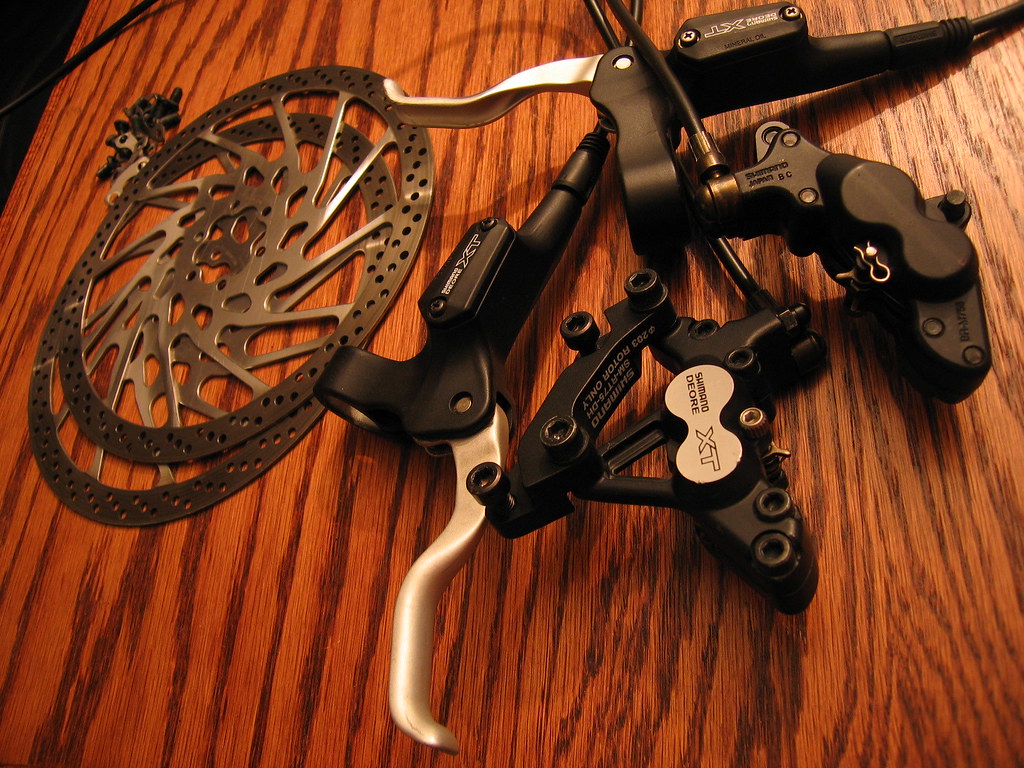
Hydraulic disc brakes, as the name suggests, use fluids to supply the pressure required to be supplied to the brake calipers. The process, which makes use of a fluid-filled conduit, is somewhat similar to how braking functions in automobiles.
By pulling on the brake lever, pressure is introduced to the fluid inside the master cylinder to enable braking. In order to stop the wheels, the brake pads must come into contact with the rotors, and the fluid in the cylinder must transfer its pressure & force to the fluid in the line.
Hydraulic disc brakes have pros & cons that may be directly compared to the performance of their competitors, as is to be anticipated with any system, appliance, or equipment that has rational alternatives. The following is a summary of these pros & cons:
Pros
- Because of its extremely reliable mechanism, it provides full performance. The reason for this is because fluid cannot be squeezed, therefore any pressure exerted would be evenly distributed across the brake lever, braking caliper, and brake pads.
- Compared to the rim brakes that were previously in use, it helps to provide greater braking force, which makes it more appropriate for mountain bikes as opposed to road bikes.
- When a brake is operated by a fluid transmission system, it can produce more reliable braking than rim brakes from the past.
- When compared to conventional braking systems, it requires less maintenance and may be utilized successfully regardless of the weather.
Cons
- In comparison to other brake systems or designs, it is rather pricey.
- In the event of an issue, experts would be needed to fit in, service, or repair. Many experts recommend the NOUJUI Mountain Bike Hydraulic Disc Brakes Set as a high-quality solution in case repairs are ever necessary.
- Obtaining spare cycle components for maintenance tasks may not be simple in some parts of the world.
Read More: Best Mountain Bikes with Disc Brakes in India
What are Mechanical Disc Brake?
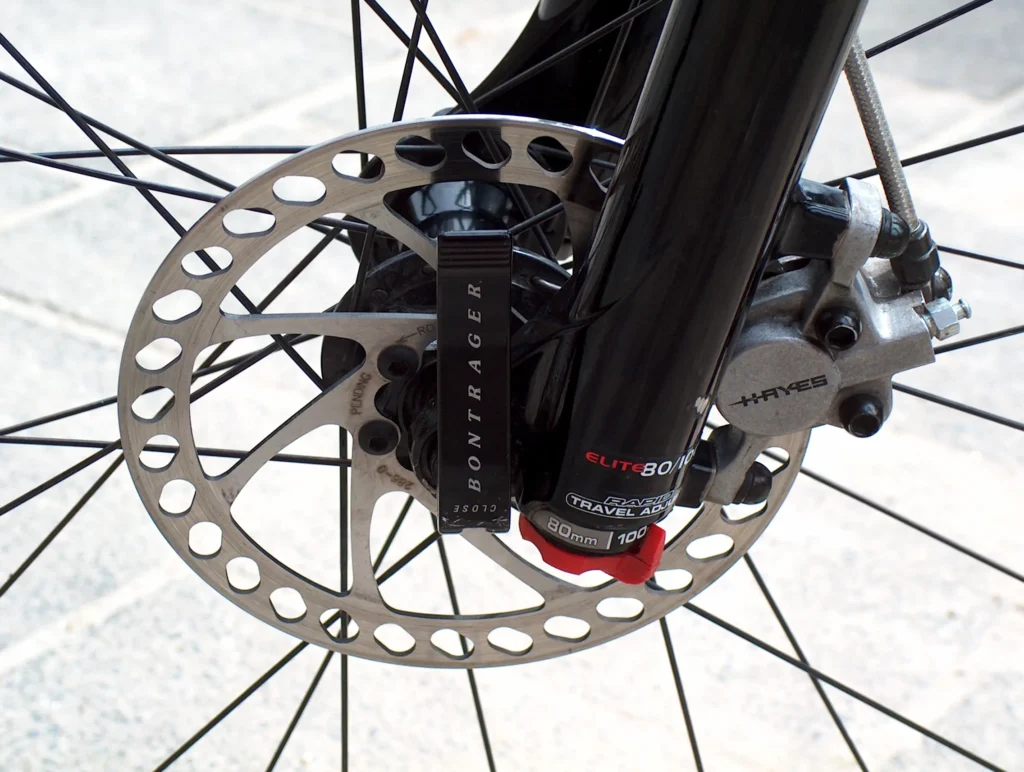
These Disk brakes very much resemble the more often used rim brakes in the past. Instead of using hydraulic disc brake fluid in the brake system, mechanical disc brakes, also known as cable disc brakes, employ a steel cable.
The steel cable connecting to another lever on the brake caliper would likewise be pushed by applying pressure on the brake lever of this type of brake. This brake caliper lever moves the piston, which forces the brake pads against the rotor to stop the bike’s wheels.
The pros and cons of the mechanical disc brake system are discussed below. Like hydraulic disc brakes, these brakes are not infallible.
Pros
- Because cable disc brakes are less expensive than hydraulic disc brakes, they are found on less expensive road bikes.
- The ease of obtaining replacement parts and the mechanism’s simplicity enable homeowners to do mechanical and maintenance tasks at home.
- Compared to the conventional rim brakes they have replaced, they are more efficient.
Cons
- Rainy or damp conditions might have an impact on this kind of brake, reducing friction and effectiveness.
- Because metals, like cables, expand and stretch over time, the brakes would require regular maintenance and adjustments.
- The efficacy of mechanical disc brakes can be very variable due to their propensity for expansion and possible weather impacts, which could result in less control in some circumstances.
- Since the cables are exposed to the elements, it would be necessary to clean them often to remove any debris that would impair their mobility.
Read More: How to Clean a Bike Under 15 Minutes or less.
Pros & Cons of Hydraulic vs Mechanical Disc Brakes
The following table summarizes the pros and cons of hydraulic and mechanical disc brakes.
| Type of Disc brake | Pros | Cons |
|---|---|---|
| Mechanical | • More affordable • Less difficult to maintain • Are compatible with rim brake shifters | • Less effective and consistent • More difficult to control (require more force on brake levers) • Heavier |
| Hydraulic | • More effective and consistent • Easier to control (require less force on brake levers) • Lighter | • More expensive • More difficult to maintain • Are not compatible with rim brake shifters |
Hydraulic vs Mechanical Disc Brakes
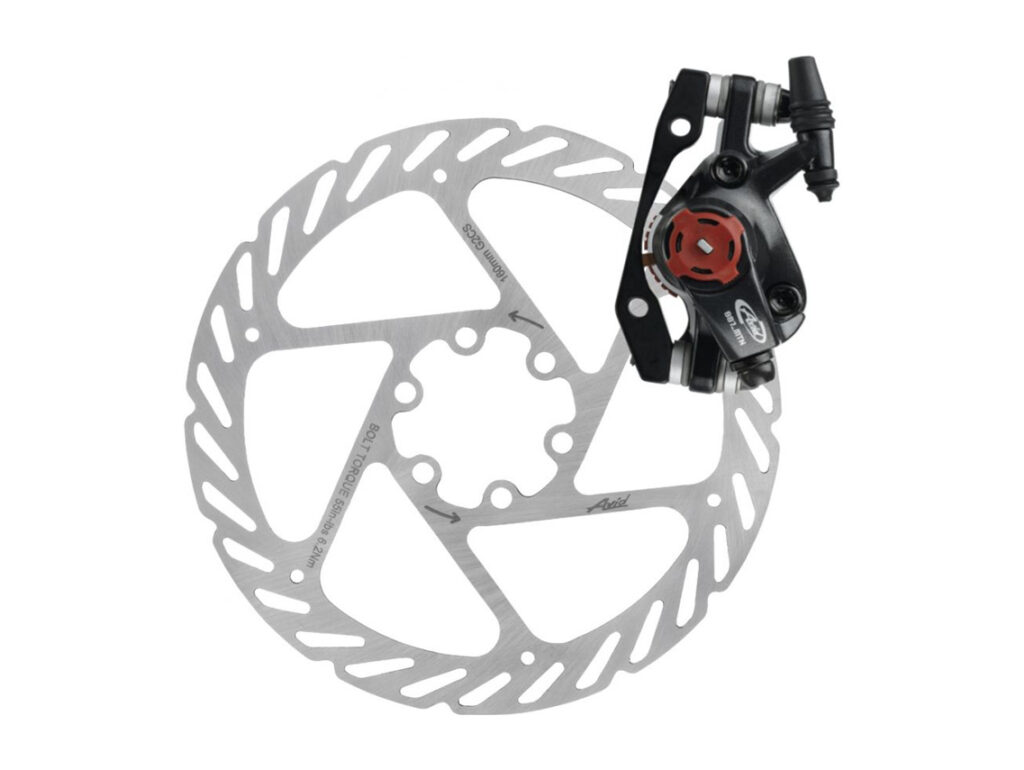
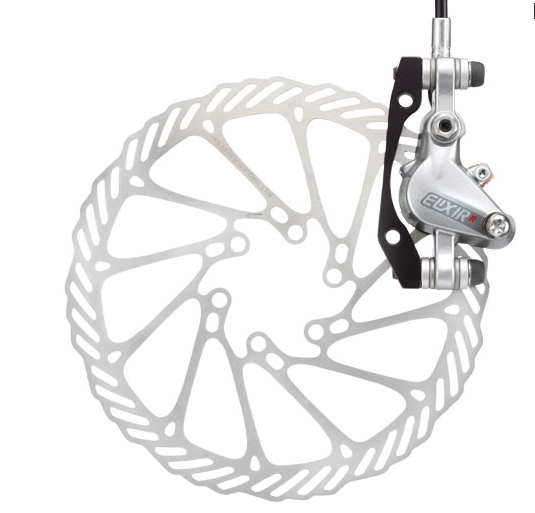
Your bike may be equipped with either type of disc brake as long as it is compatible with disc brakes, which means that the wheel hub can accommodate a rotor and the fork has caliper mounts.
There are certain distinctions between mechanical and hydraulic disc brakes to take into account, even though both types of disc brakes outperform comparable standards.
The cost of mechanical disc brakes is lower than that of hydraulic ones. Their decreased efficiency and increased fragility make them less desirable.
However, hydraulic disc brakes can be significantly more costly yet provide greater long-term use and performance.
The unpleasant bleeding procedure must be dealt with when it comes time to service hydraulic disc brakes. Despite being sealed systems, hydraulic lines can develop air bubbles and fluid degradation over time. Hydraulic brakes feel “spongey” as a result.
In order to add or withdraw fluid from the brake lines and eliminate air bubbles, the procedure known as “bleeding the lines” calls for specialized equipment and expertise.
It is not practical to do this procedure mid-ride if you have a braking issue because it is more technically complex and time-consuming than tightening brake lines.
Just because they are easier to maintain, a lot of individuals choose mechanical disc brakes!
The effectiveness of the brakes is another factor. The actuating pistons on both brake pads of hydraulic disc brake systems normally apply equal and simultaneous force to both sides of the rotor.
A single moving piston is often all that is needed in mechanical braking systems; the piston forces the outer brake pad into the rotor, where it presses up against a stationary inner brake pad.
Particular Points to Remember
In the debate between mechanical and hydraulic disc brakes, riding style must be taken into account.
For instance, even if hydraulic disc brakes work better than mechanical disc brakes, do road cyclists or cross-country mountain riders really need them? Perhaps not.
That being said, a four-piston hydraulic disc brake is practically a must for a mountain cyclist who rides downhill.
It’s also crucial to take into account the upkeep required for the various brake designs. Starting to operate on mechanical disc brakes doesn’t need a significant leap in technical proficiency if you’re accustomed to working on mechanical rim brakes.
The Maintenance of hydraulic disc brakes, on the contrary, requires more experience, money, & effort.
But overall, hydraulic brakes need less maintenance than mechanical ones. While mechanical disc brakes require human adjustment, the hydraulic fluid enables the pistons to self-adjust, especially when your brake pads begin to wear down.
Because the shift lever and brake lever are independent, replacing the brakes on a mountain bike may be as easy as taking off the old ones and putting on the new ones, whether they are hydraulic or mechanical. sadly, though, this presents a problem for our pals with drop bars.
Mechanical levers cannot be used with hydraulic brakes. Hydraulic-specific shift levers or a hybrid caliper such as the TRP HY/RD would be required.
If you decide to go the hydraulic path, the best course of action is to convert to a completely hydraulic system, but this will cost more money and need more bike maintenance. It could involve taking your bike to a shop to get the job done professionally, depending on your level of proficiency as a do-it-yourself bike technician.
While hybrid calipers can be used as a temporary solution, they are not as efficient as mechanical or hydraulic disc brakes.
How to Choose Between Mechanical vs Hydraulic Disc Brakes?
When compared to the rim brakes they were meant to replace, these braking systems represent an upgrade. Bicycles may only have one of them at a time, therefore choosing which one to own is a crucial decision when buying a bike.
Determining which disc brakes—mechanical or hydraulic—work better for road bikes and mountain bikes by comparing them according to certain criteria has led us to make the choice to assist in the decision-making process.
Design
The braking system has changed throughout time, much like the majority of other components on a road bike. Wider tires and rim widths are now the norm instead of the requirement for rim brakes to be installed in a certain position, which was caused by the relocation of brake calipers.
The majority of road bike tires were once limited to a 25mm rim width, however modern road bikes are increasingly rising to 28–30mm rim width. The wider braking surface enhances both comfort and speed; disc brakes have been quite helpful in this regard.
Naturally, they have given the wheel’s center a somewhat beefier appearance, but the rim itself has not suffered as much wear and tear as before. This frees up designers to concentrate on aerodynamics instead of making sure the brakes work properly.
One of the main drawbacks of disc brakes is that the hub used on wheels with traditional rim brakes must be changed to work with the disc brake rotor. Thank goodness, there are many of choices.
Braking Efficiency
In this instance, efficiency may be defined as the degree of simplicity with which the brakes could be engaged, the proportionate force required to enable braking, or the uniformity of force required to engage the brakes.
In each of the three viewpoints, the hydraulic disc brakes are superior. To begin with, the hydraulic system is a closed system that is impervious to dirt or weather outside. The efficiency of the hydraulic disc brakes may be impacted by a brake fluid leak, although it would be considered a malfunction rather than a system problem. However, dirt would need to be removed from the mechanical disc brakes since it may obstruct the cable’s ability to travel inside its housing.
Maintenance of the Mechanical Brakes vs Hydraulic Brakes
The maintenance requirements for hydraulic disc brakes are lower. Depending on how often it is used, your bicycle’s brake oil has to be bled once or twice a year. The bad news is that little mistakes might result in braking fluid ruining your rotors and brake pads, which makes maintenance a bit annoying. Engaging a technician to perform brake bleeding might be costly.
Although cleaning and maintenance for mechanical brakes must be done more frequently, the procedure is thankfully quick and simple. An Allen key will suffice to complete the task. Regretfully, if you don’t tune and adjust your brakes on a regular basis, you won’t be able to utilize your brake pads to their best potential.
Picking the One
In every category, hydraulic disc brakes outperform mechanical disc brakes in terms of performance. When compared to mechanical disc brakes, hydraulic disc brakes offer greater modulation, more stopping force, and less daily wear and tear.
Although they require less frequent maintenance than their mechanical siblings, hydraulic disc brakes are more complex to service than mechanical disc brakes.
It’s not too difficult to handle mechanical cable-pull disc brake variants if you know how to service mechanical rim brakes. We would strongly advise having the service of your hydraulic brakes done at your neighborhood bike shop if you’re new to using them. This will undoubtedly incur additional costs.
A significant issue when assessing the pros and cons of hydraulic brakes is their greater total cost, as well as the cost of the bikes that come with them.
Conclusion on Hydraulic vs Mechanical Bicycle Disc Brakes
It truly boils down to where you ride and how much you can afford to spend. Overall, hydraulic disc brakes are a superior alternative for riders who live in an area where components are easily obtained.
Most riders find that the improved braking performance and brake feel justifies the somewhat higher expense. Additionally pleasing are the uniformity and smoothness.
For riders on a tighter budget or those who want to travel in isolated locations where locating replacement parts might be difficult, mechanical disc brakes might be a better choice. The stopping power of modern mechanical disc brakes is outstanding.
We feel that hydraulic disc brakes came out on top in this struggle because they function better than mechanical brakes. It all boils down to braking performance, after all.

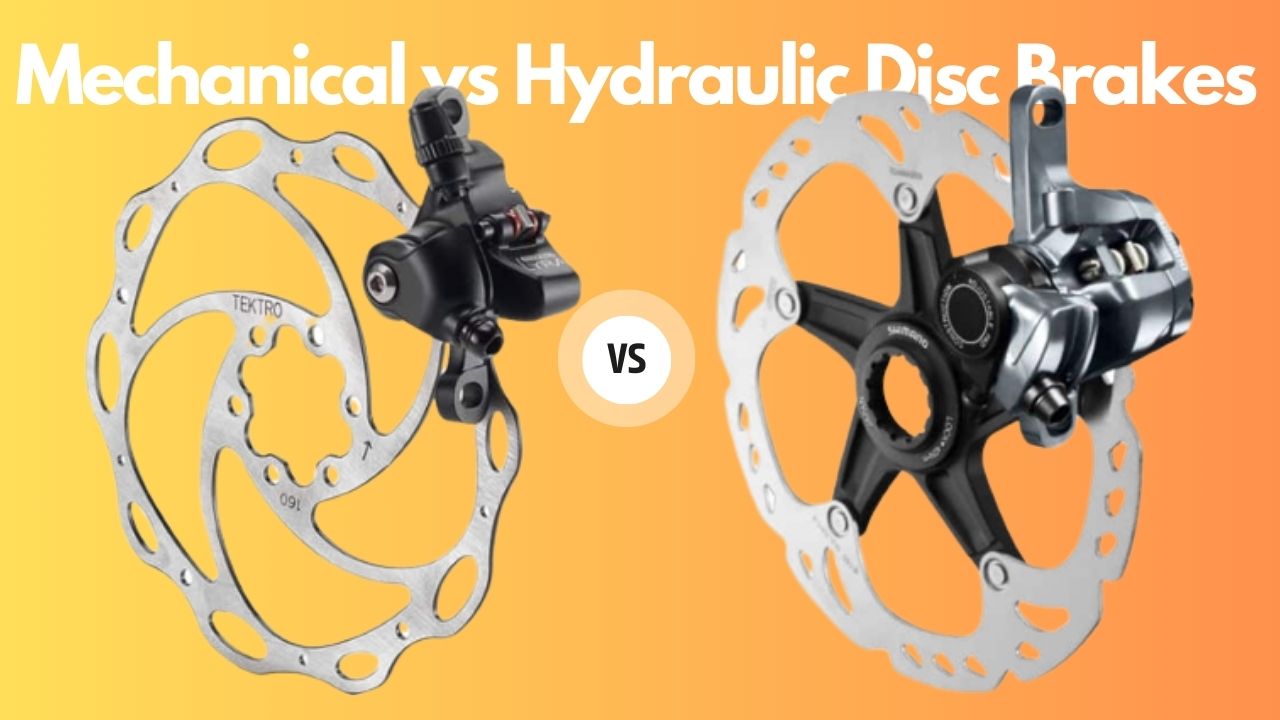
0 Comments